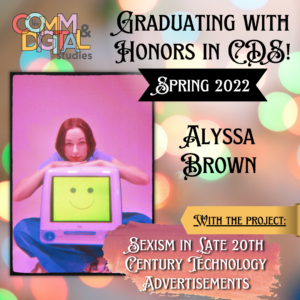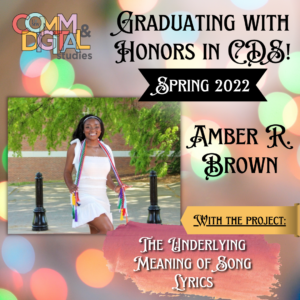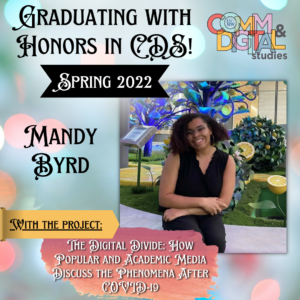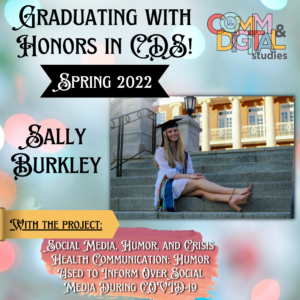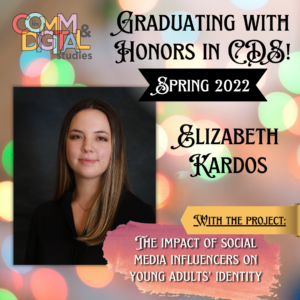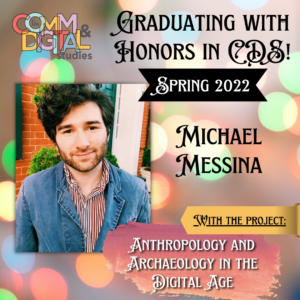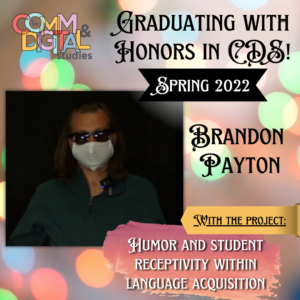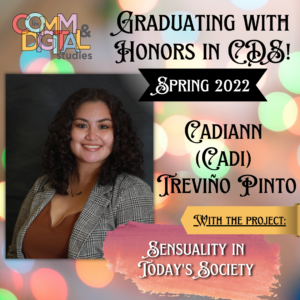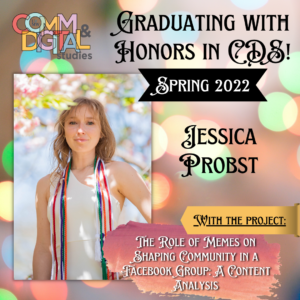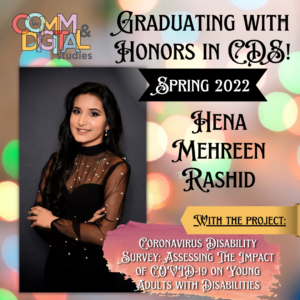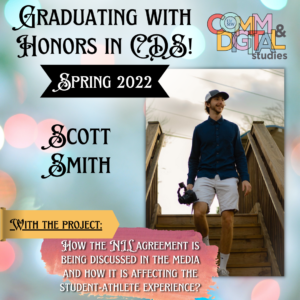Congratulations to the following CDS majors who graduated with Honors in Spring 2022. They have done impressive work- see their abstracts below, and you can find their projects in Eagle Scholar.
Social media platforms’ concentration of diversity and interactions has accelerated the rate of cultural change on the Internet. With the rise of Tik Tok, a video-sharing social media platform, language used by marginalized groups is being incorporated into the platform’s slang due to the rapid rotation of trends. This study aims to provide data to a new field related to Tik Tok culture and the effects of trends on marginalized groups.
Using qualitative content analysis, this article studies an LGBTQ+-inspired Tik Tok trend to determine if the portmanteau of “-ussy”’s meaning has changed from its original use and if trends inspired by marginalized cultures can benefit the marginalized group on the platform.
Results demonstrated a lack of LGBTQ+ presence in videos in the trend, however, there was evidence to suggest that the trend has aided LGBTQ+ creators in succeeding on the platform due to the trend’s effects on the platform’s algorithm.
Technology advertisements of the late 20th century communicate humanity’s hopes for a retro-renaissance and express our desires of living in a present that embraces futurism over modernism. Despite their glamor, these advertisements capture one of our greatest weaknesses, our inability to progress alongside our machines. Women are often portrayed as one of three things: the ideal housewife, the background noise that accompanies a man’s space, or an ornament decorating the advertised product (Boddewyn, 1991, p. 26). The consumer is paying for the emotions they associate with the perceived ad in addition to the technology. Obscure technology advertisements are reliant on the same method of luring in customers, if not more reliant than mainstream technologies. This research is necessary because of its intentions to preserve the history of defunct technology. Our choice to record pieces of technology belonging to human history should not depend on their popularity or a short lived shelf life. These advertisements are relevant because they make room for meaningful conversations regarding human reliance on gender roles and their attractiveness in consumer marketability. Through analyzing three obscure technology advertisements ranging from the years 1969-1984, it is proven that late 20th century ads rely on binary gender roles and the female body to excite a variety of largely male audiences.
Many artists use lyrical dissonance to communicate their hardships, struggles, and/or fears via their lyrics, but oftentimes will disguise the true meaning behind “upbeat” music to
appeal to a listening audience. This is known as lyrical dissonance when the lyrics evoke a different emotion than the rhythm of the music. This research studies how attentive participants are to a song’s actual meaning when listening to an array of songs. This is tested through a method of presenting participants with three songs: “Prison Song” by System of a Down, “Hey Ya! By Outkast, and “Pumped Up Kicks” by FosterThePeople. The survey asked open-ended and feelings based multiple choice questions for participants to share their emotions and understanding of the song they listened to. The results supported the hypothesis being that listeners are less attentive to the actual meaning of song lyrics when there is “upbeat” music added.
Digital technology has grown to become an essential part of today’s society, particularly in the United States. A need for the internet is being weaved rapidly into most parts of modern western culture, from general communication, work, and education, most recently due to safety precautions enacted to combat the COVID-19 pandemic. It behooves us to examine how this rapid transition affected people who were a step ahead or behind in terms of meeting the basic requirements of a new digital society. The difference between members of society with access to adequate internet and devices such as computers and individuals who do not have access to these basic technologies is called the digital divide (Eastin et al., 2015, p. 417). The definition also acknowledges the inequalities stemming from this divide as it affects economic, educational, and other social outcomes and opportunities due to lack of access and in turn, a lack of technical skill (Merriam-Webster, (n.d.)). In addition, the divide is viewed as disproportionately representing communities of color, people with low socioeconomic status, and individuals who reside in rural parts of the country (Eastin et al., 2015, p. 416).
The importance of this digital divide, as evidenced by becoming a persisting phenomenon, leaves an opportunity to explore how this topic is discussed in popular and news and academic media in the United States. This topic will promote digital literacy and digital rhetoric, as it addresses a relevant phenomenon in digital media that has tremendous effects on the public’s ability to understand and discuss digital inequality.
With the recent events of COVID-19, it is necessary to examine how everyday citizens responded to the public health messages delivered by The Center for Disease Control and Prevention and the U.S. government and how these responses revealed and impacted the effectiveness of the organization’s messages. Furthermore, it is important to consider the potential humor has as an information spreading tool within the collaborative medium of social media. This study analyzes three different digital humor artifacts using a chronological rhetorical analysis to understand how we communicate health crisis initiatives over social media. The research findings show the change in humorous reactions on social media as the CDC’s messaging changed and became more solidified. This insight demonstrates the necessity for messaging to be more focused and solidified throughout an organization and their affiliates because of social medias participatory nature. This research also revealed that using humor to cope and increase engagement are prominent within the digital medium of social media and has the potential to have a further reach.
The representation in TV shows are proven to impact the way people come to view themselves and other groups of people. Therefore, casting decisions play a critical role in dismantling the patriarchy, white supremacy, and heteronormativity. Season 1 of Bridgerton was praised for bringing a diverse cast to the Regency era. This study aims to determine whether or not Bridgerton is an intersectional feminist show. In order to do this, I used a content analysis approach and looked for emergent themes. I argue that the show fails to be an intersectional feminist one because gender, race, and sexuality never come together: the white women were the challengers of gender norms, the only gay people shown to exist were two white men, and race was essentially not addressed and various racial tropes were used. Bridgerton failed to recognize that in order to make an impact, more steps need to be taken other than only having a diverse cast. When compared to past shows, Bridgerton is a step in the right direction, however there is still a long way to go.
This paper is an exploration of queer representation across the Scream film franchise. The original Scream premiered in 1996 and in 2022 and the series was rebooted with new characters that are the second generation of the characters in the first film. The direct parallels between the films allow for an analysis of how representation has grown with the times. The ultimate goal of this paper was to investigate two different aspects of on screen representation: quantity (how many queer characters are shown?) and quality (Are they queer coded? Are they shown to actually be queer? Do they embody queer stereotypes? Are they a main character? Do they have a personality and exhibit behaviors beyond their queerness?). More recently productions are working towards adding more diversity on screen, but the desire to be seen as diverse begs the question of quality. Many tv shows and movies will add diverse characters purely to capitalize on the fact that they are a “diverse” production. Quality checking these characters to see if they are given a main role, have a complex character, and are more than just a stereotype is more important than ever. My goal is to the access these factors. Ultimately, this paper answers the research question, “How has the quality and quantity of queer representation in the Scream franchise changed over time to reflect modern values?”
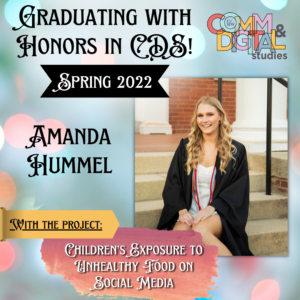 My study investigated unhealthy food ads and if they could have a potential negative impact on children viewing the ads. My study focused on themes that emerged from the videos, these themes are discussed in the paper. A content analysis was performed to look at ads from the YouTube platform, looking at 25 YouTube food ads. While viewing the videos I noted certain themes were emerging, following this I counted the number of times each theme was presented in the videos. My research found that the theme of family dynamic was the highest theme emerging 11 times throughout the 25 videos. Family dynamic was shown by including the children in the ads, eating dinner as a family, or helping mom with groceries are a few examples. Some limitations of this story was lack of time and access to resources. More research needs to be done by talking to children and getting their responses to the ads.
My study investigated unhealthy food ads and if they could have a potential negative impact on children viewing the ads. My study focused on themes that emerged from the videos, these themes are discussed in the paper. A content analysis was performed to look at ads from the YouTube platform, looking at 25 YouTube food ads. While viewing the videos I noted certain themes were emerging, following this I counted the number of times each theme was presented in the videos. My research found that the theme of family dynamic was the highest theme emerging 11 times throughout the 25 videos. Family dynamic was shown by including the children in the ads, eating dinner as a family, or helping mom with groceries are a few examples. Some limitations of this story was lack of time and access to resources. More research needs to be done by talking to children and getting their responses to the ads.
This paper will lay out the research on the impact of social media influencers on young adults’ identity. The components of identity that will be focused on are lifestyle decisions and interests; this includes appearance (fashion, makeup, etc.), health and nutrition, and activities. Since the surge of social media influencers (SMIs) on all social networking sites, there have been studies conducted on the effects that SMIs have on consumers of the internet. Most of the research looks at how internet users view ads put out by influencers and the concept of parasocial relationships with internet personalities correlated with negative and positive effects. It focuses on how adolescents are encouraged to explore their identity through social media, but not necessarily in relation to SMIs. I strive to fill the gap in research that focuses on SMIs and identity. The argument of this research is that social media influencers have an impact on at least one sector of young adults’ identity. This paper will outline the literature that supports my claims, the research questions, methods, findings, and discussion of the research.
The present study examines season 8 of MTV’s Are You The One?, a reality dating show that featured a cast made up entirely of sexually fluid individuals, meaning gender did not play a role in any of the contestants’ attraction to one another. While the show did include explicit representation of individuals within the LGBT+ community, “Queering Reality TV: An Analysis of Are You the One? Season 8” utilized qualitative content analysis methods to determine whether this representation was more positive than it was negative. Using a code sheet that included twelve total variables– six positive and six negative– the study identified events presented within the show that supported responsible, realistic representation, as well as representation that promoted common misconceptions of sexually fluid individuals. The study found that, while Are You the One? season 8 did play heavily into stereotypes of queer individuals, it also explicitly embraced its contestants’ identities and educated the general public on issues pertinent to the wider LGBT+ community. As a result, research found the show to be an overall positive example of representation within the limits of previously-established queer reality dating shows.
Promoters often use visual rhetoric in media advertising as a persuasive strategy to encourage consumers to make purchases. These rhetorical strategies have advanced alongside technology, thus creating new rhetorical devices in modern day. This study analyzes how visual rhetoric seen in digital advertisements via Instagram influences consumers. Using a qualitative content analysis, I determined that most studies analyzed social media’s influence, but did not address the rhetorical strategies used on Instagram. Knowing that social media influencers utilize visual rhetoric to create their brand, this prompted the question: do influencers create more persuasive advertisements than those of an official brand? After conducting a qualitative survey, research suggests that influencers’ use of visual rhetoric influences consumers to engage with an advertisement. The findings revealed two main themes: consumers’ desire for relatability and overall appeal of the advertisements’ aesthetic. Influencers create content that is more appealing to consumers; therefore, making their audience more willing to purchase from them.
The purpose of this paper is to demonstrate how three-dimensional (3D) virtual worlds pose as promising platforms for education. These metaverses create new and objective learning experiences that force professors to rethink how and where students learn. While this profound way of teaching constitutes new opportunities, there are plenty of challenges that have limited its use. Secondary literature was analyzed to investigate how this technology can support future education. A case study was also performed at the University of Mary Washington to record the experience and opinions students had on the topic. The results of the research and survey conducted showcased how 3D virtual worlds have great potential for being used in academia. Many educators often view these environments with skepticism while majority of students are receptive to the idea. These 3D spaces have been proven to promote immersive, stimulating and constructivist learning. However, costs and accessibility issues are the main reasons that 3D virtual worlds have not been globally accepted in education.
Archaeology is known for the research, study, excavation, and exploration of the past. Often the present advancements at hand are not thought about when it comes to this field of study. This paper aims to shine a light on how the digital era has progressed the ways in which the archaeological field opened up like never before due to the all of the social mediums in which archaeologists can share their research and findings. Theory is explored both new and old on globalization within the field and how everything arrived to where it is now. Questions are researched through content analysis of those theories as well as ongoing digital content from those within archaeology. Community building amongst people within the field through social media has allowed for creative explanation and education to the masses. This research paper aims to highlight all of the ways in which the digital era has brought about archaeology to the world.
 The role of service animals (SA) in public life is often disputed online where people show their emotion, feelings, and experiences with SAs or as an SA handler. The purpose of this study was to examine how public social media discusses service animals using the hashtag #service animal. Instagram posts regarding the hashtag #serviceanimal were studied under an inductive approach to content analysis using open coding. The results show that service animals are spoken of in a positive light in public social media posts which is contradictory to the physical public’s perception. There is great responsibility bestowed upon service animals to loyally protect and serve their handlers. Many people have trouble understanding this concept without first-hand experience. Social media can be a means of educating within and outside the service animal community on proper etiquette and manners surrounding service animals.
The role of service animals (SA) in public life is often disputed online where people show their emotion, feelings, and experiences with SAs or as an SA handler. The purpose of this study was to examine how public social media discusses service animals using the hashtag #service animal. Instagram posts regarding the hashtag #serviceanimal were studied under an inductive approach to content analysis using open coding. The results show that service animals are spoken of in a positive light in public social media posts which is contradictory to the physical public’s perception. There is great responsibility bestowed upon service animals to loyally protect and serve their handlers. Many people have trouble understanding this concept without first-hand experience. Social media can be a means of educating within and outside the service animal community on proper etiquette and manners surrounding service animals.
This research study honors humor as a powerful linguistic tool for language acquisition and is aimed to better understand student receptivity to the proposal of humor implementation into language learning environments. This research study also set out to identify areas of deficiency within language learning environments that may be addressable with humor. A mixed method approach was implemented to gather data from a fifteen question survey. The survey was distributed online and designed to collect qualitative and quantitative data. Participants included 29 L2+ students varying in languages and levels of study. This study provides data, or evidence, for high student receptivity of proposed humor integrated language learning within L2+ environments. The data also indicates evidence of student dissatisfaction with L2+ cultural enrichment and a probable deficiency within L2+ environments. This study provides data for future research on student receptivity to humor and supports existing L2+ research studies aimed at understanding the significance, and opportunity thereof, for humor-integration to positively supplement existing language curriculums.
Sex and sensuality tend to be taboo topics of conversation in society. However, that has been proven to be more problematic than the topics themselves. This paper explores different types of sexual relationships, focusing most on the BDSM community. It also goes deeper into media’s influence on people’s perception of kinks and fetishes as well as the influence it has on their own preferences. Through a self-reported survey, this study investigates what types of kinks and fetishes tend to be more common than others and how comfortable people are talking about said topics.
This paper explores how a community is formed in the Facebook group The M in UMW Stands for Memes and what role memes play in shaping a sense of community and sharing information. Based on previous research, there was a common theme found within the results of the studies; memes can be used to communicate information and a shared understanding is needed to have a sustainable online community. I chose to complete this study using a content analysis which allowed for an evaluation of the shared language used in the posts revealing how this mode of communication creates a sustainable online community. In doing so, I was able to answer the questions; what is the shared language and cultural capital needed to understand the discussions in the group and how are memes used to create community and communicate to the group members? I found that cultural capital played a crucial role in understanding the content of the group which was formed by the shared language in the posts and that humor was used across all posts to communicate information. In this paper, I argue that the effects of the group’s norms and values, consistent use of humor in posts, and creation of cultural capital through the shared language revealed how this community was formed and maintained using memes.
This paper seeks to inform individuals of the importance of digital inclusivity, dimmish the digital divide, and accessibility to technological services of college students who experience a form of disability. The United States has conducted minimal research on the digital disability rhetoric, promoted minimal disability-inclusive measures to protect the rights and well-being of college students, and minimal assistance to mitigate Coronavirus (COVID-19) impacts to this population subgroup. This subject can have a big impact on individuals who suffer from disability stigma, low accessibility issues, and who have been disproportionately impacted by the pandemic. Furthermore, this subject will benefit college students who argue in the favor of digital inclusion to help improve online rhetoric and become better equipped with communication technologies. Using survey research, this paper explains the experiences and solutions provided by college students to help alleviate the serious implications resulting from the COVID-19 pandemic.
 The world has become integrated with technology at a rapid rate. The rhetoric of online platforms, due to technology integration, allows people to connect, converse, and meet others who have common character traits. Eyman (2015) defines rhetoric as an action that intends to persuade and form meaning. These platforms are referred to as “social media,” which are online networks made by people who use rhetoric to form, confirm, and reinforce the connections of platform users with common character traits: Hobbies, thoughts, race, gender, or religion. These common character traits make up one’s social identity. This study details the findings of an extensive literature review with data used from journals, articles, dissertations, and abstracts from the University of Mary Washington library database; to identify how social media’s rhetoric shapes social identity through the formation of online groups and reveal how algorithms aid in the confirmation and reinforcement of social identity. This study also uses critical discourse analysis to compare different social groups with similar social identities, illustrating how social media’s rhetoric forms, confirms, and reinforces social identity and provides insight into algorithm’s role throughout it all.
The world has become integrated with technology at a rapid rate. The rhetoric of online platforms, due to technology integration, allows people to connect, converse, and meet others who have common character traits. Eyman (2015) defines rhetoric as an action that intends to persuade and form meaning. These platforms are referred to as “social media,” which are online networks made by people who use rhetoric to form, confirm, and reinforce the connections of platform users with common character traits: Hobbies, thoughts, race, gender, or religion. These common character traits make up one’s social identity. This study details the findings of an extensive literature review with data used from journals, articles, dissertations, and abstracts from the University of Mary Washington library database; to identify how social media’s rhetoric shapes social identity through the formation of online groups and reveal how algorithms aid in the confirmation and reinforcement of social identity. This study also uses critical discourse analysis to compare different social groups with similar social identities, illustrating how social media’s rhetoric forms, confirms, and reinforces social identity and provides insight into algorithm’s role throughout it all.
The Name, Image and Likeness Agreement has opened hundreds of doors for college athletics to make money based on their “likeness” and not their performance on the field. This new agreement levels the playing field for all athletes in college. Through a content analysis this paper will take a look at how the NIL is being discussed in various media channels such as TikTok and how this agreement is affecting the student athlete experience. Not every athlete is striking mega deals, but with this agreement everyone from Junior college to Division 1 has the opportunity to make money through avenues such as social media. While current athletes are the ones profiting, alumni, branding coaches and universities are all jumping in on the issue. As there are many unknowns about the rules of NIL, this paper will bring light to how those in power writing the rules are navigating these gray areas.

